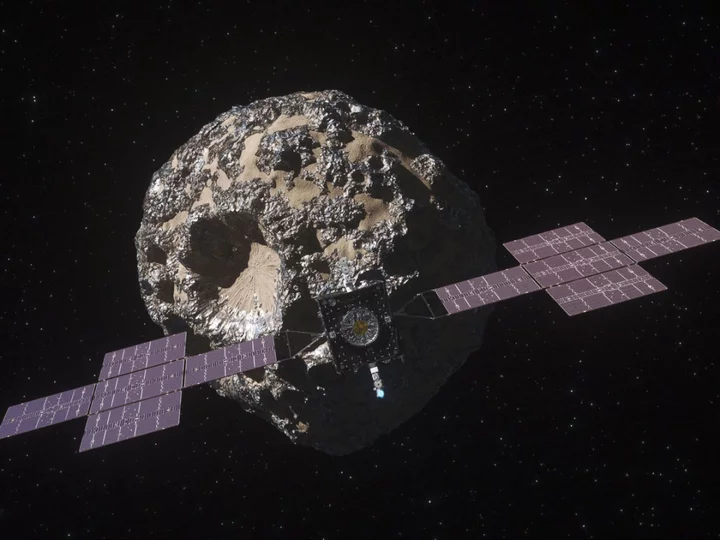
Nasa’s Psyche mission set to launch to ancient metal asteroid today: Live updates
Nasa is about to set off to a distant, metal asteroid that could tell us how planets form. On Friday, the spacecraft – currently folded in the cargo bay of a SpaceX rocket – will leave from the Kennedy Space Centre and begin a mission that will see it arrive at what is thought to be an ancient remnant of a protoplanet in 2029. Propelled by a system of solar-electric ion thrusters being used for the first time on an interplanetary mission, the spacecraft - about the size of a small van - is expected to reach its target on the outer fringes of the main asteroid belt between Mars and Jupiter nearly six years from now. It would then orbit Psyche for 26 months, scanning the asteroid with instruments built to measure the asteroid’s gravity, magnetic proprieties and composition. Psyche measures roughly 173 miles (279 km) across at its widest point. The leading hypothesis for this asteroid’s origin is that Psyche is the once-molten, long-frozen inner hulk of a baby planet torn apart by collisions with other celestial bodies at the dawn of the solar system. It orbits the sun about three times farther than Earth, even at its closest to our planet.
2023-10-13 21:49

'All hands on deck.' How Israel's vital tech sector is navigating the war
Israel's vast tech sector has seen its fair share of crises, from financial downturns and the Covid-19 pandemic to periodic flare-ups in the Israeli-Palestinian conflict. Each time, the industry has bounced back, demonstrating why the country of just 9 million people is known as the world's "startup nation."
2023-10-13 20:46
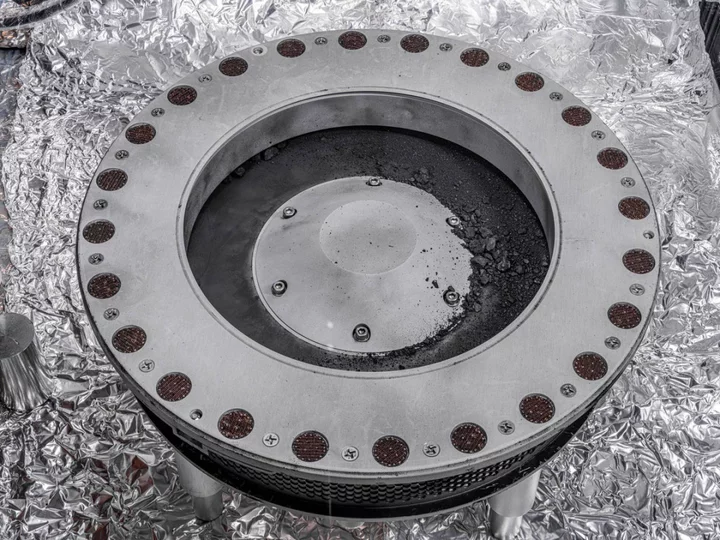
Nasa opens up pieces of a distant asteroid transported back to Earth
Nasa has revealed chunks of a distant asteroid that were transported back down to Earth. The dark, dusty sample comes from a 4.5-billion-year-old asteroid, and might include the “building blocks of life”, the space agency said. Already, the material from the asteroid Bennu has been found to include high-carbon content and water, the space agency said. But it will be distributed around the world with a view to finding out everything from the history of our solar system to how life came about. Scientists and space agency leaders showed photos and video of the asteroid material - returned to Earth last month - at a live streamed event at the Johnson Space Centre in Houston, Texas. The display came after a capsule containing an estimated 250g of rocks and dust collected from asteroid Bennu, touched down in the Utah desert near Salt Lake City on September 24. Nasa has said it was “the biggest, carbon-rich asteroid sample ever delivered to Earth”, and its contents have now been hailed as “scientific treasure”. Nasa administrator Bill Nelson said the sample will “help scientists investigate the origins of life on our own planet for generations to come”. He added: “Almost everything we do at Nasa seeks to answer questions about who we are and where we come from. “Nasa missions like Osiris-Rex will improve our understanding of asteroids that could threaten Earth while giving us a glimpse into what lies beyond. “The sample has made it back to Earth, but there is still so much science to come - science like we’ve never seen before.” Almost 60 million miles away, asteroid Bennu is a 4.5-billion-year-old remnant of our early solar system and scientists believe it can help shed light on how planets formed and evolved. The spacecraft launched on September 8 2016 and arrived at Bennu in December 2018. It dropped the samples off sealed in a capsule last month. “Already this is scientific treasure,” said the mission’s lead scientist, Professor Dante Lauretta, of the University of Arizona on Wednesday. In a statement, he added: “As we peer into the ancient secrets preserved within the dust and rocks of asteroid Bennu, we are unlocking a time capsule that offers us profound insights into the origins of our solar system. “The bounty of carbon-rich material and the abundant presence of water-bearing clay minerals are just the tip of the cosmic iceberg. “These discoveries, made possible through years of dedicated collaboration and cutting-edge science, propel us on a journey to understand not only our celestial neighbourhood but also the potential for life’s beginnings. “With each revelation from Bennu, we draw closer to unravelling the mysteries of our cosmic heritage.” Nasa‘s mission goal was to collect was 60 grams of asteroid sample. But when the canister lid was opened, Nasa said scientists discovered “bonus material” covering the outside of the collector head, canister lid, and base. There was so much extra material it slowed down the process of collecting and containing the primary sample, Nasa said. Scientists are not sure exactly how much of Bennu they brought back because the main sample chamber has not yet been opened. Mr Lauretta said: “It’s been going slow and meticulous, but the science is already starting.” He said there is “a whole treasure chest of extraterrestrial material” still to be examined. During Wednesday’s press conference, Osiris-Rex sample analyst Daniel Glavin added: “This stuff is an astrobiologist’s dream, I just can’t wait to get at it. “We’re going to learn so much about the origin of the solar system, the evolution and potentially how even life started here on Earth.” Additional reporting by agencies Read More ‘Ring of fire’ solar eclipse this month will be last until 2046 Prada to design Nasa’s next-gen space suits for Artemis astronauts 1.2 mile-high ‘dust devil’ spotted on Mars by Nasa’s Perseverance rover Rover captures one-mile-high whirlwind on Mars Earth hit by a huge solar storm that would devastate civilisation, trees show Scientists see afterglow from huge planets crashing into each other for first time
2023-10-12 20:19

Fortnite Chapter 4 Season 5 Starter Pack Skin Revealed
The Fortnite Chapter 4 Season 5 Starter Pack skin is Heartbreak Ranger and comes with a matching Pickaxe and Back Bling for $3.99.
2023-10-12 02:45
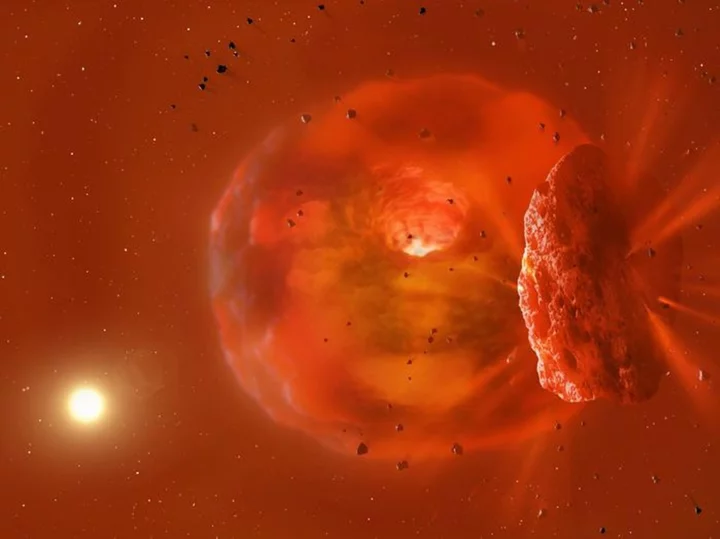
Scientists watch afterglow from two huge planets crashing into each other for first time
Astronomers have seen the “afterglow” of two huge planets crashing into each other for the first time. Scientists watched as the heat and dust that were left behind from the crash swirled in front of their star, allowing them to see the aftermath of the explosion. The incident happened when two ice giant planets collided with each other, around a star like our own Sun. A blaze of light and dust resulted, which could be seen from Earth. Those effects were first spotted by an amateur astronomer social media, who noticed unusual light coming from the star. It had brightened up in infrared – getting lighter at those wavelengths for three years – and then the optical light began fading. Scientists then watched the star in an attempt to understand what was happening. They monitored for further changes at the star, named ASASSN-21qj, to see how the star’s brightness changed. “To be honest, this observation was a complete surprise to me. When we originally shared the visible light curve of this star with other astronomers, we started watching it with a network of other telescopes,” said co- lead author Matthew Kenworthy from Leiden University. “An astronomer on social media pointed out that the star brightened up in the infrared over a thousand days before the optical fading. I knew then this was an unusual event.” Their research suggested that the glow was the heat from the collision, which could be picked up by Nasa’s Neowise mission. Then the optical light began to fade when the dust covered the star, over a period of three years. “Our calculations and computer models indicate the temperature and size of the glowing material, as well as the amount of time the glow has lasted, is consistent with the collision of two ice giant exoplanets,” said co-lead author Simon Lock from the University of Bristol. The dust is then expected to star smearing out. Astronomers hope to confirm their theories by watching as that happens, since it should be visible both from Earth and with Nasa’s James Webb Space Telescope – and they might see that dust begin its journey into something else. It will be fascinating to observe further developments. Ultimately, the mass of material around the remnant may condense to form a retinue of moons that will orbit around this new planet,” said Zoe Leinhardt, from the University of Bristol, who was a co-author on the study. The research is described in a paper, ‘A planetary collision afterglow and transit of the resultant debris cloud’, published in Nature today. Read More 1.2 mile-high ‘dust devil’ spotted on Mars by Nasa’s Perseverance rover Researchers capture first-ever afterglow of huge planetary collision Earth hit by a huge solar storm that would devastate civilisation, trees show
2023-10-12 00:59
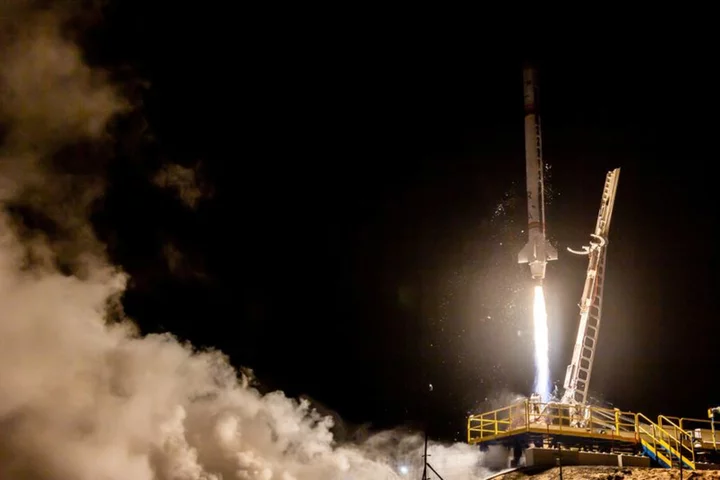
Spain's PLD Space launches private rocket in milestone for Europe
By Graham Keeley and Tim Hepher MADRID (Reuters) -Spanish company PLD Space launched its recoverable Miura-1 rocket early on Saturday
2023-10-08 00:50
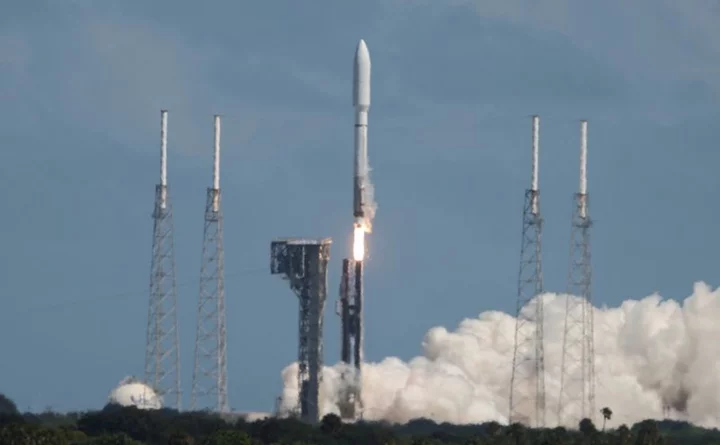
Amazon launches first test satellites for internet network
By Joey Roulette WASHINGTON (Reuters) -Amazon's first pair of prototype satellites for its planned Kuiper internet network were launched into
2023-10-07 02:24
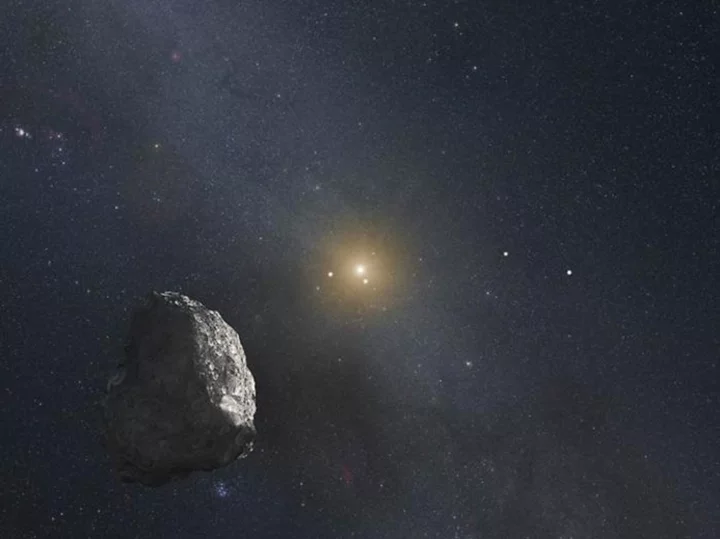
‘Planet Nine’ hidden world at the edge of our solar system could actually be something else, scientists say
A supposed “planet nine” that lies hidden at the edge of our solar system could actually be something else entirely, according to scientists. The unexplained movement of objects at the edge of our solar system has led some to propose that they are being influenced by another world, hidden in the dark distance of our planetary neighbourhood, that they have referred to as planet nine. Objects at the far reaches of the solar system behave as if they are being pulled around by an object that we cannot see, which is probably another planet, they suggest. But a new study by researchers Harsh Mathur, a professor of physics at Case Western Reserve University, and Katherine Brown, an associate professor of physics at Hamilton College, say that those movements are instead the result of a modified law of gravity. The scientists plotted what would happen if the objects were being governed by a theory known as Modified Newtonian Dynamics or MOND. That suggests that Newton’s usual gravity only works up to a point – that in the outer regions of galaxies, for instance, gravity behaves in unusual ways. They found that the data lined up, and applying the MOND theory to the existing observations seemed to predict them exactly. “The alignment was striking,” said Professor Mathur. They note that the findings do not necessarily rule out planet nine – or another explanation for what is going on. Some researchers have suggested other explanations for what the objects could be, for instance, while others have suggested that the claimed effect is just the result of when the distant objects tend to be observed. “Regardless of the outcome, this work highlights the potential for the outer solar system to serve as a laboratory for testing gravity and studying fundamental problems of physics,” said Professor Brown. The findings are reported in a paper, ‘Modified Newtonian Dynamics as an Alternative to the Planet Nine Hypothesis’, published in The Astronomical Journal. Read More Watch live: Amazon launches first internet satellites aiming to rival Starlink Stargazing in October: A sleeping giant Prada to design Nasa’s next-gen space suits for Artemis astronauts
2023-10-07 01:52

Earth hit by blast of energy from dead star so powerful that scientists can’t explain it
Earth has been hit by a blast from a dead star so energetic that scientists cannot explain it. The burst of gamma rays, originating in a dead star known as a pulsar, is the most high energy of its kind ever seen. It was equivalent about ten trillion times the energy of visible light, or 20 tera-electronvolts. Scientists are unable to explain exactly what kind of a scenario could lead a pulsar to emit such intense energy, and the researchers behind the breakthrough say that it “requires a rethinking of how these natural accelerators work”. Scientists hope that they can find yet more powerful energy blasts from pulsars, with a view to better understanding how they are formed. Pulsars are formed when a star dies, exploding in a supernova and leaving behind a tiny, dead star. They are just 20 kilometres across, and spin extremely fast with a powerful magnetic field. “These dead stars are almost entirely made up of neutrons and are incredibly dense: a teaspoon of their material has a mass of more than five billion tonnes, or about 900 times the mass of the Great Pyramid of Giza,” said Emma de Oña Wilhelmi, a scientist at the High Energy Stereoscopic System observatory in Namibia that detected the blast. As pulsars spin, they throw out beams of electromagnetic radiation, throwing it out like a cosmic lighthouse. That means that someone in one spot – like the Earth – will see the radiation pulses flash in a regular rhythm as they spin past. The radiation is thought to be the result of fast electrons that are produced and thrown out by the the pulsar’s magnetosphere, which is made up of plasma and electromagnetic fields that surround the star and spin with it. Scientists can search the radiation for different energy bands within the electromagnetic spectrum, helping them understand it. When scientists previously did that with the Vela pulsar examined in the new study, they found that it was the brightest everseen in the radio band, and the brightest persistent source in the giga-electronvolts. But the new research found that there is a part of the radiation with even more high energy components. “That is about 200 times more energetic than all radiation ever detected before from this object,” said co-author Christo Venter from the North-West University in South Africa. Scientists don’t know exactly how that could happen. 
“This result challenges our previous knowledge of pulsars and requires a rethinking of how these natural accelerators work,” says Arache Djannati-Atai from the Astroparticle & Cosmology (APC) laboratory in France, who led the research. “The traditional scheme according to which particles are accelerated along magnetic field lines within or slightly outside the magnetosphere cannot sufficiently explain our observations. “Perhaps we are witnessing the acceleration of particles through the so-called magnetic reconnection process beyond the light cylinder, which still somehow preserves the rotational pattern? But even this scenario faces difficulties to explain how such extreme radiation is produced.” An article describing the findings, ‘Discovery of a Radiation Component from the Vela Pulsar Reaching 20 Teraelectronvolts’, is published today in the journal Nature Astronomy. Read More ‘Ring of fire’ solar eclipse this month will be last until 2046 Mystery behind massive star suddenly vanishing decoded New discovery is ‘holy grail’ breakthrough in search for aliens, scientist say ‘Ring of fire’ solar eclipse this month will be last until 2046 Mystery behind massive star suddenly vanishing decoded New discovery is ‘holy grail’ breakthrough in search for aliens, scientist say
2023-10-05 23:16

NBA 2K24 Best Dunk Package: Current and Next Gen
The NBA 2K24 best dunk packages on Current and Next Gen are LeBron James, Giannis Antetokounmpo, and One Foot Big Man Tomahawk.
2023-10-04 03:17

U.S. FAA closes probe of Blue Origin's 2022 rocket mishap, requires engine redesign
By Joey Roulette WASHINGTON (Reuters) -The U.S. Federal Aviation Administration on Wednesday said it has closed a probe into Blue
2023-09-28 05:52
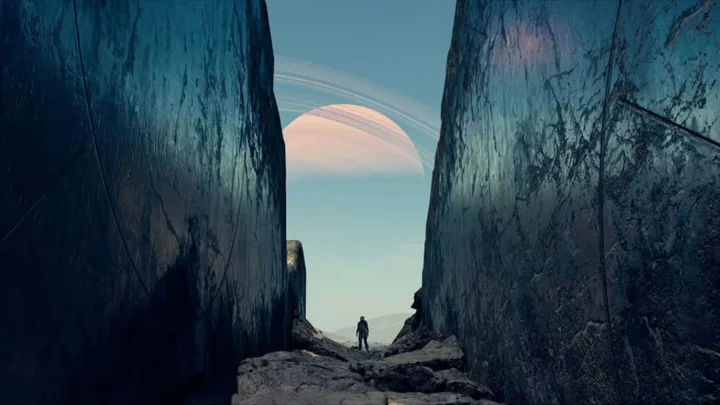
Starfield Shattered Space Story Expansion: Release Date, Known Info
There aren't many public details about Shattered Space. Here's everything we know about the Starfield expansion so far.
2023-09-28 04:57
